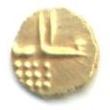| SPECIFICATIONS | |
| Denomination | One Fanam |
| Metal XRF | Gold Au0.760 |
| Alloy | Ag%Cu 0.84 |
| Type | Struck |
| Diameter | 8. mm |
| Thickness | mm |
| Weight Legal | 0.363 gms |
| Weight | 0.39 gms |
| Shape | Round |
| Edge | Plain |
| DieAxis | O° |


|

|

| ||||||||||||||||||||||||
The design is that of the Malabar Vira raya fanam.
Obverse :
An oval placed vertically and open at the top, with one dot inside and
another outside to the left; below this are two curved lines
springing upwards and then curving downwards from two dots, with two
rows of dots in the space so formed. It is derived from the
masaka
standing figure, the open oval being the head and body, and the curved
lines the outline of the legs and dhoti
Reverse :
A thin horizontal line, bent upwards on the left, having two dots
about the middle, from which rise two vertical lines; below are three
rows of dots, each of four. It may be the last stage of corruption of
the sitting figure or perhaps of Nagari letters.
The word "fanam" occurs in a twelfth century Tamil inscription at Budumuttawa; the Sinhala aka may be meant. That the fanam, as distinct from the aka, was brought to Lanka from the Tamil country is apparent from the formation of its Sinhala name panama, plur. panam. Its currency was continuous from the middle of the fourteenth century. It is then first mentioned in 1344 by Ibn Batutah, who informs us that one hundred were equal to six gold dinars; the average weight of the Maghrabi dinar of the time being about 70 grains, the fanam, if of the same touch, would be 4.2 grains, but this species of coin usually is not of the best gold, and its weight was probably then as in latter times about 5.8 grains. In 1347-8 the Gadaladeniya inscription states that the pay of the workmen engaged on the construction of that vihare amounted to 3,000 fanams; while provision was made for an annual tax of one fanam on each house. Fanams are also mentioned not infrequently in the grants of the Kotte period; they appear with masakas in the Pepiliyana inscription.
In Nunes' Lyvro dos Pesos written in 1554 the native money in use at Colombo is said to have been fanams of very base gold, 30 of which went to the xerafim, each, therefore, being worth 10 reis; about the same time in the Invcntario do Thesouro do Rei de Ceylao, in which the treasures of the Kotte king and of the Sitawaka temple, plundered by the Portuguese in 1551, are entered. By 1614, however, the silver fanam re-appears as a regular sub-unit of the currency, the oldest recorded rating being 12 to the larin; it is mentioned as in use in the reign of Maydunne (1551-1580). In Knox's time (1659-1679) the Kandyan king struck only silver fanam , such as are still found. These Sinhala panam therefore presumably have a continuous history, at least from the time of Mayadunne, if not from 1506.
Text from
* Ceylon Coins and Currency By H. W. Codrington. Colombo 1924
Page 80-81 Chapter VI Medieval Ceylon.
The coin was scanned at 300dpi and the images are displayed at 300dpi.
This gold fanam was purchased in September 1998 on the web
from Uno Barner Jensen.
It is very similer to KM#30 the gold Viraraya Fanam of Rama
Varma V (AD 1880-1885) of Indian Princely state of Travancore
(Trivandrum - extream southwest tip of india) it is closer in detail
to the silver fanam purchased in Kandy.
The description from Codrington above mentions a dot "outside to the
left" on obverse and "bent upwards on the left" on reverse. Both
features are to the right on the fanam shown above and also on Pl.168 of
Codrington. The true identity of this fanam still needs to be
ascertained.
Maybe the webuse of Panama is bad since same spelling is used
for Country name although pronunciation is totally different.